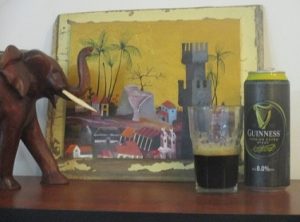
One sad piece of news I received during 2021 was that Zac Sansom, a good friend of mine while we worked for the Voluntary Service Overseas organisation in Ethiopia from 1999 to 2001, had passed away. He’d fallen victim to the lethal combination of a Covid-19 infection and an existing health issue that’d weakened his immune system.
One of my best memories of Zac was during the summer of 2000. I bumped into him in Addis Ababa two days before I was due to take an early-morning flight to the UK and spend a fortnight with my family. It transpired that we’d booked into the same hotel, the Wutma, in Addis’s bustling, nightlife-centric Piazza district. On the first evening – well, starting on the first afternoon – we embarked on a pub crawl and, as a result, the following morning, 24 hours before my flight, I did not feel a particularly well man. When Zac, somewhat the worse for wear too, joined me for breakfast in the Wutma’s dining area, I told him:
“I have a plane to catch first thing tomorrow morning. So, we are not going out on another epic drinking session today.”
“Sure,” he said sheepishly. “So, uh, what will we do today instead?”
I thought about it. “Well, we could go for a walk.”
Thus, late that morning, we set off on our walk. We walked to the top of the street where the Wutma was located, turned a corner and walked along another street. We passed Piazza’s venerable Taitu Hotel and turned another corner. Then we found ourselves facing another hotel, a smaller and more ramshackle one than the Taitu, whose façade was bedecked with banners and posters for… Guinness.
Ireland’s greatest brand? The black stuff? The black nectar? Irish champagne? Mother’s milk? Liffey water? Here, in Addis Ababa?
This was very strange. Ethiopians enjoy their beer and the country has – or at least, back then, had – a good number of indigenous brews, and there was even an Ethiopian stout, Hakim, produced by the Harar Brewery. But never, ever had we seen the name Guinness on a label on a bar or shop-shelf, and certainly not slathered prominently over the whole front of a building.
Meanwhile, it sounded like a carnival was taking place in the hotel’s bar. Curious, we went up its front steps and looked inside. The bar was crammed with people who were clearly having a good time. More Guinness banners and posters hung on the walls, Guinness tablecloths covered the tables, Guinness beermats sat on the tablecloths, and glasses of the famously black-but-creamy-topped Guinness stood on the beermats. An Ethiopian guy wearing a smart suit came over and introduced himself as the Guinness company’s newly-recruited marketing executive in Ethiopia. He looked delighted that two foreigners had shown their faces at the festivities.
He explained. Today was a historic day. It was when Guinness went on sale for the first time ever in Ethiopia. The hotel was hosting the launch event and there was a special offer to encourage curious Ethiopians to partake of and acquaint themselves with Guinness: buy one and get one free!
Zac looked at me and ventured, “Well, I suppose we could stay and have one… Or two…”
Feeling that fate had started to conspire against me, and resistance was going to be futile, I sighed, “All right. Just one. Or two.”
As it turned out, we consumed considerably more than two that day.
I still managed to catch the plane the next morning, but it was definitely not the most enjoyable flight I’ve ever made. Hunched in my seat, stricken with an unholy blend of airsickness and severe hungover-ness, I cursed Zac and cursed fate for positioning the launch-day of Guinness in Ethiopia so painfully close to my big journey. Of course, I should also have cursed myself for being so weak-willed. But hey, I’m from Northern Ireland. I’m good at blaming other people for my shortcomings.
A few days ago, I was reminded of this incident because I discovered that Guinness had arrived in Sri Lanka, the country that’s been my home since 2014. It came, apparently, with none of the fanfare that’d accompanied its entry into Ethiopia 21 years ago. One day, it wasn’t in Sri Lanka. The next day, it was. As if by magic, it was suddenly occupying space on the shelves behind the bar-counter in Colombo’s Cricket Club, suddenly on display in the liquor section at my local branch of Keells Supermarket, suddenly jostling aside the cans of Carlsberg and Lion Lager in the fridge of my local off-licence, Walt & Row Associates on Marine Drive.
This surprised me because I’d assumed that Guinness would never get past Sri Lanka’s strict import regulations. There was a protectionist element to this – the island’s Lion Brewery produces its own stout, claimed to be an eye-watering 8.8% proof, and I didn’t think the authorities wanted a foreign stout competing with their own homegrown one. Thus, even the Irish Pub on Colombo’s Park Street has been a Guinness-free zone until now. The closest you could get to replicating the Irish experience in there was to sip an 8.8%-proof Lion Stout whilst sitting under a framed picture of Bono.
I didn’t expect my first canned Guinness in Sri Lanka to taste like the real McCoy – and nope, it didn’t. The Guinness flavour was there but it lacked some of the requisite smoothness and creaminess. Coming out of a can, it had a faintly metallic tang too. Actually, it reminded me of how canned Guinness tasted in the UK back in the 1980s, when I was a teenager, before widgets and other new technology were deployed to enhance its taste. Also, perhaps in an effort to compensate for the metallic-ness, the stout seemed to have been sweetened. As a result, it was slightly reminiscent of Sweetheart Stout, another drink that I quaffed in my teenage years.
That said, it’s better than no Guinness at all.
I’ll no doubt be downing a few cans of the black stuff during the festive season. And I’ll drink them to the memory of my good mate, the late, great Zac Sansom.

© Guinness / From the Irish Times
(No, that’s not him or me in the picture. That’s Rutger Hauer!)
